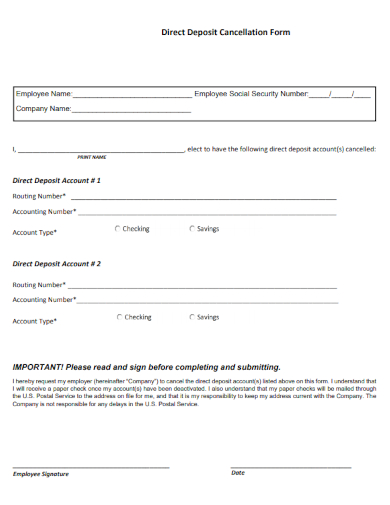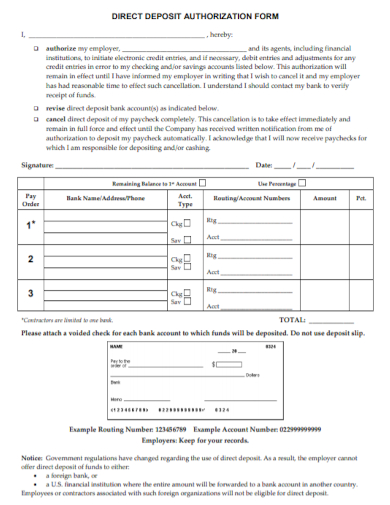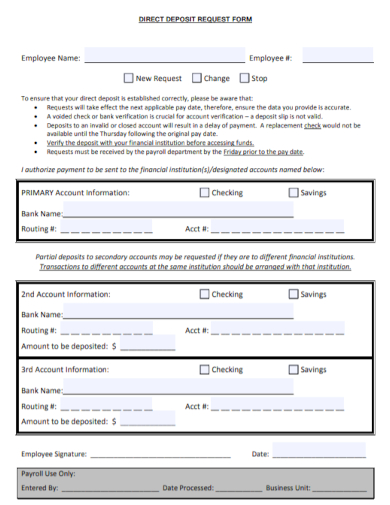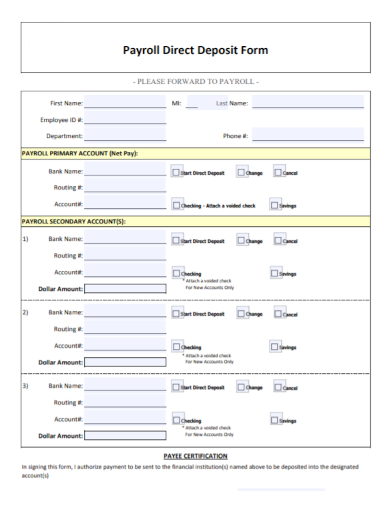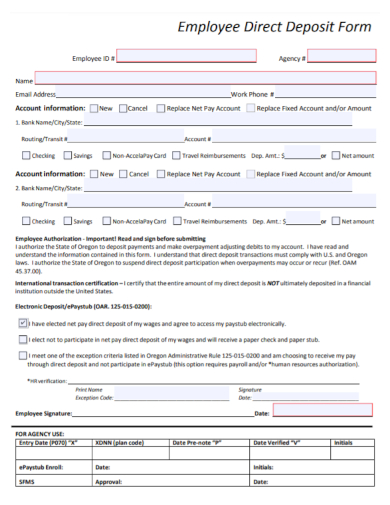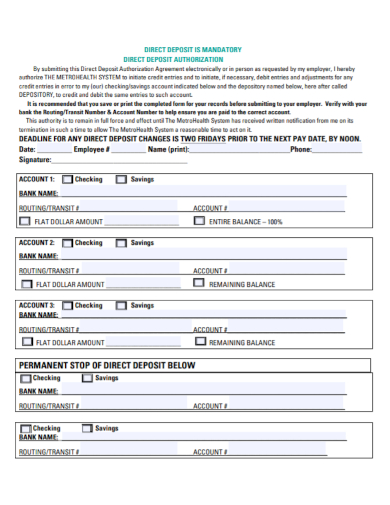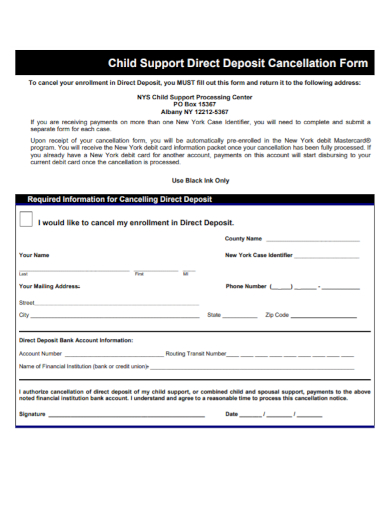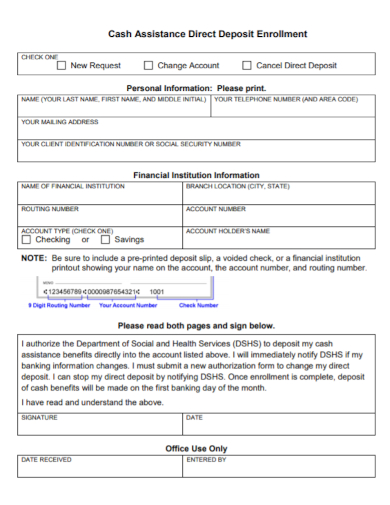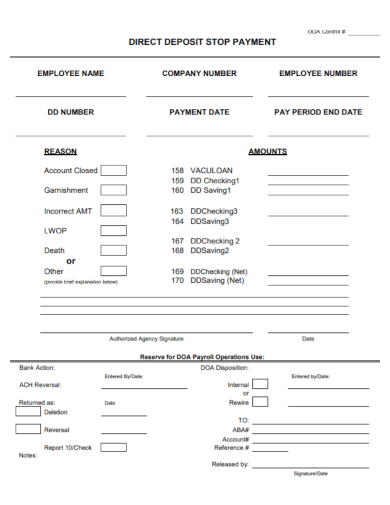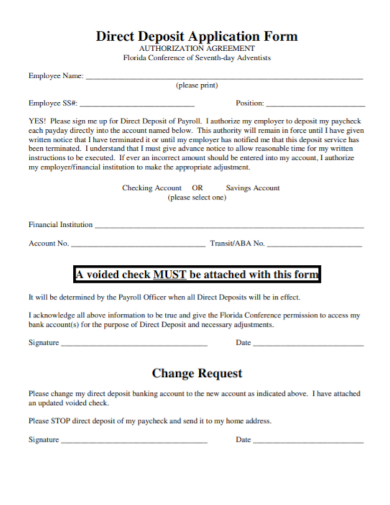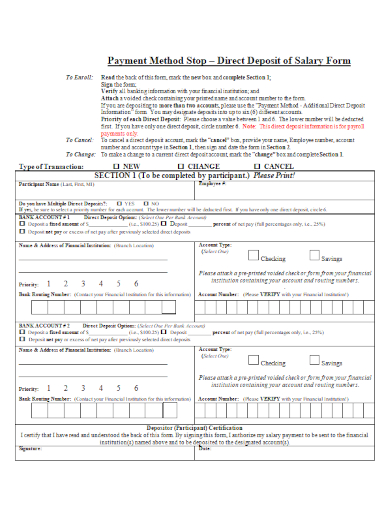A stop direct deposit is an official business activity to make a request to a financial institution to cancel direct payments to a bank account holder. This is done for several reasons ranging from personal issues to official executive mandates and can only be enacted if the issuance of payment has not been processed yet by the recipient. In order to stop direct deposits, the account holder must contact his bank and provide the necessary information pertaining to the recipient of the deposit and the check that is currently subjected to cancellation to cancel it.
Before doing this process, what are the things that you need to consider if you are a business owner? Is it beneficial to you as an employer or is it an advantage to the recipient of such payment deposit? To help you understand the process and make your own request to stop direct deposits, you can download our free Stop Direct Deposit Form Samples. Keep reading.
10+ Stop Direct Deposit Form Samples
1. Stop Direct Deposit Cancellation Form
2. Stop Direct Deposit Authorization Form
3. Stop Direct Deposit Request Form
4. Stop Payroll Direct Deposit Form
5. Stop Employee Direct Deposit Form
6. Permanent Stop Direct Deposit Form
7. Child Support Direct Deposit Cancellation Form
8. Cash Stop Direct Deposit Enrollment Form
9. Direct Deposit Stop Payment Form
10. Stop Direct Deposit Application Form
11. Payment Stop Direct Deposit of Salary Form
Considerations to Stop Direct Deposits
- Review payment data
The first thing that you need to consider is if the payment or check has already been claimed or should be reversed. You also need to consider the number of jobs for such cancelation so you can decide whether or not to do it to avoid the hassle of work. To give you an idea of what’s the best thing to do is to consult your payroll department if there are pending transactions that need to be done under the recipient’s name so that you can decide on what steps to do.
- Process of cancelation
Canceling direct deposits entails a whole process that encompasses both internal to the business or organization and banking institution. Since it is considered to be a special case for retrieving an amount of money that’s supposed to be given already, the process to do it can be a bit tedious. While online banking can help ease the complexities, processing it in person and going through the long process is still the best way to ensure that no money was taken from you as the depositor and to avoid incidences of hacking.
- Cancelation fees
Banks issue a fee in order to stop a direct deposit and prevent it from being paid. In most situations, a fee of roughly $30 is deducted from the issuer’s account depending on which bank the deposit was processed and what mode of transaction is used (over the telephone, online, or physical banking). If you are looking into canceling several checks, it may be best to cancel them all at once so that cancelation fees can be reduced. The process of stopping direct deposits from your bank account usually lasts for several months up to a maximum of 6 months within which your bank will have to track its progress from time to time.
- Check on the recipient
Whether you want to cancel the deposit or not, check on the recipient’s situation if the cancelation is timely or if it will become a burden to them. If you’re an employer who has mistakenly scheduled to stop a direct deposit due to some errors or unintentional approvals of such payment, you could think of it as advanced payment for a service rendered or a bonus for doing an extra mile at work. You could look into their life situation and weigh their options against yours. It could be that the money from the payment deposit will be used as payment for hospital expenses for their ill family members or to pay off school fees for their children. Either way, everything doesn’t have to follow certain policies and company guidelines if it doesn’t really have to consider one’s life situations.
FAQs
What is a certificate of deposit?
A document formalizing a deposit made and agreeing of the depositor to keep the money in a bank.
What does a savings account mean?
A banking account in which deposited money is subject to interest increases for emergency or for short or long-term goals.
What is a returned item fee?
A fee charged to a depositor’s account for trying to deposit a bounced check. The charge is done if the check writer doesn’t have enough funds on their account or if the account is closed.
Related Posts
FREE 5+ Column Charts Samples in PDF
FREE 5+ College Essay Outline Samples in PDF
FREE 10+ Blood Donor Parent/Guardian Consent Form Samples & Templates in PDF
Meeting Appointment Letter
Research Interest Statement
Witness Letter
FREE 23+ Sample Employment Contract Templates in Google Docs | MS Word | Pages | PDF
FREE 7+ Awesome Holiday Flyer Templates in PSD
FREE 9+ Home Remodeling Contract Templates in MS Word | Apple Pages | Google Docs | PDF
FREE 13+ IT Support Contract Templates in PDF | MS Word | Excel | Google Docs | Pages
Argumentative Writing Samples & Templates
FREE 11+ Interior Design Contract Samples in PDF | MS Word | Google Docs | Apple Pages
FREE 3+ Management Weekly Report Samples in PDF | DOC
FREE 10+ Process Safety Management Samples in PDF | DOC
FREE 8+ Project Stakeholder Management Samples in PDF | DOC

